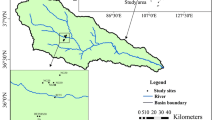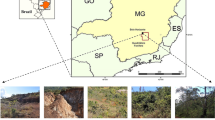Abstract
The effects of vegetation restoration on matrix structure and erosion resistance of iron tailings were studied at dump sites in Malanzhuang, Qian’an, Hebei province, China. The restoration process involved soil spray sowing restoration model with Rhus typhina, soil and iron tailings admixture spray sowing restoration model with Amorpha fruticosa Linn. and six-hole brick restoration model with Pinus tabulaeformis Carrière.–Amorpha fruticosa Linn. mixed-forest, and direct restoration model with Hippophae rhamnoides and Sabina vulgaris. Results show that the composition and distribution of particles and aggregates were closely related to erosion resistance (P < 0.05), indicating that matrix structure of iron tailings play an important role in erosion resistance. The improvement in matrix structure of iron tailings by the different restoration models was in the order of R. typhina soil spray sowing > A. fruticosa soil and iron tailings admixture spray sowing > mixed-forest six-hole brick > H. rhamnoides direct restoration > S. vulgaris direct restoration. The R. typhina soil spray sowing restoration model resulted in the greatest improvement in matrix structure of iron tailings, increasing the clay (10.6%) and large particle aggregates (18.7%) contents significantly (P < 0.01). Simultaneously, particle population, grading conditions (Cu = 28.86, Cs = 1.65), and aggregate stability (6.02) were significantly improved. The A. fruticosa soil and iron tailings admixture spray sowing restoration model, which effectively improved particle distribution (Cu = 8.51, Cs = 1.07), increased the number of large aggregates considerably (9.6%), thereby increasing aggregate stability (6.2). The six-hole brick model significantly increased the number of large aggregates (4.0%) and improved the stability of aggregates (6.2). H. rhamnoides direct restoration improved the stability of aggregates (5.1) but showed no other significant improvements. The effect of S. vulgaris direct restoration on matrix structure of iron tailings was not significant. Due to its dependence on matrix structure of iron tailings, the erosion resistance of R. typhina soil spray sowing restoration model was the greatest, while that of S. vulgaris direct restoration was the weakest. There was no significant difference in the erosion resistance of the other models. Overall, vegetation restoration supplemented by soil spray sowing restoration and engineering measures is superior to in situ direct vegetation restoration in the short-term. In-situ direct restoration has long-term ecological significance because of its advanced concept of near-natural restoration and the advantages of low cost, easy operation, and low secondary damage.





Similar content being viewed by others
References
Amponsah-Dacosta F (2015) A field-scale performance evaluation of erosion control measures for slopes of mine tailings dams. In: Agreeing on solutions for more sustainable mine water management—proceedings of the 10th ICARD and IMWA annual conference. Santiago, Chile (GECAMIN) p 262
Andruschkewitsch R, Koch HJ, Ludwig B (2014) Effect of long-term tillage treatments on the temporal dynamics of water-stable aggregates and on macro-aggregate turnover at three German sites. Geoderma 217:57–64
Burri K, Graf F, Böll A (2009) Revegetation measures improve soil aggregate stability: a case study of a landslide area in Central Switzerland. For Snow Landsc Res 82(1):45–60
Chen Y, Li CG, Xu XH, Guo J, Li YL, Liu HX (2015) Soil and water conservation function of Rhus typhina L. forest in iron tailings. J Soil Water Conserv 29(3):106–111
Dinno A (2009) Implementing Horn’s parallel analysis for principal component analysis and factor analysis. Stata J 9(2):291–298
Duan Y, Zhao H, Fan W (2012) The function of water and soil conservation of Rhus typhina in hilly area of Taihang Mountain. Chin Agric Sci Bull 28(25):43–46
Ferreira Da Silva E, Cardoso Fonseca E, Matos JX, Patinha C, Reis P, Santos Oliveira JM (2005) The effect of unconfined mine tailings on the geochemistry of soils, sediments and surface waters of the lousal area (Iberian Pyrite Belt, Southern Portugal). Land Degrad Dev 16(2):213–228
Gee GW, Or D (2002) Particle-size analysis. In: Dane JH, Topp GC (eds) Methods of soil analysis. Part physical methods. SSSA Book Ser. 5. SSSA, Madison, pp 255–293
Guo GL, Zhou QX (2006) Evaluation of heavy metal contamination in Phaeozem of northeast China. Environ Geochem Health 28:331–340
Guo J, He J, Li J, Xing E, Wen A, Liu Y, Yang GY (2015) Effects of different measures on water erosion control of dump slope at opencast coal mine in typical steppe. Trans Chin Soc Agric Eng 31(3):296–303
Hales TC, Ford CR, Hwang T, Vose JM, Band LE (2009) Topographic and ecologic controls on root reinforcement. J Geophys Res Earth Surf 114(F3):554–570
Inman DL (1952) Measures for describing the size distribution of sediments. J Sedim Petrol 22(3):125–145
Jordan G (2009) Sustainable mineral resources management: from regional mineral resources exploration to spatial contamination risk assessment of mining. Environ Geol 58(1):153–169
Li XY, Xu XH, Guo J, Zhao S, Li YL (2014) Effect of different forestation species on the substrate physicochemical properties and soil fauna in iron tailings. Acta Ecol Sin 34(20):5746–5757
Liu X, Zhang GC, Heathman GC, Wang YC, Huang CH (2009) Fractal features of soil particle-size distribution as affected by plant communities in the forested region of Mountain Yimeng, China. Geoderma 154:123–130
Ma YB, Niu CJ, Xu ZQ (2015) Impacts of different forestation pattern on soil properties of iron tailings. J Soil Water Conserv 29(3):242–248
Mandy P, Dominik A, Christian K, Christian R (2009) Higher plant diversity enhances soil stability in disturbed alpine ecosystems. Plant Soil 324:91–102
Morgan RPC (2005) Soil erosion and conservation, 3rd edn. Blackwell Publishing, Oxford, p 304
Mulholland BJ, Black CR, Taylor IB, Roberts JA, Lenton JR (1996) Effect of soil compaction on barley (Hordeum vulgare L.) growth: I. Possible role for ABA as a root-sourced chemical signal. J Exp Bot 47(4):539–549
Peng D, Hou X, Zongming HE, Liu LQ, Cai LP, Lin JW, Jing RR, Huang FC, Zhong JH (2016) Evolution of species diversity and soil characteristics at different stages of vegetation restoration in gold tailings. J Soil Water Conserv 30(1):159–164
Rodríguez-Lado L, Lado M (2017) Relation between soil forming factors and scaling properties of particle size distributions derived from multifractal analysis in topsoil from Galicia (NW Spain). Geoderma 287(1):147–156
Shi CT, Wang Y, Gu HY, Chen XW (2010) Soil structure characters of different soil and water conservation plantations in typical black soil region. J For Res 21(2):151–154
Shirazi MA, Hart JW, Boersma L (1988) A unifying quantitative analysis of soil texture: improvement of precision and extension of scale. Soil Sci Soc Am J 52(1):181–190
Tyler SW, Wheatcraft SW (1992) Fractal scaling of soil particle-size distributions: analysis and limitations. Soil Sci Soc Am J 56(2):362–369
Vance ED, Brookes PC, Jenkinson DS (1987) An extraction method for measuring soil microbial biomass C. Soil Biol Biochem 19(6):703–707
Wang CH (2017) Slope stability assessment based on principal component analysis and support vector machine optimized by particle swarm optimization. J Inst Disaster Prev 19(2):3–26
Wang Y, Li YL, Shi JH, Guo J, Du JY (2012) Effect of different vegetation restoration measures on the species diversity and soil properties of iron tailings. J Soil Water Conserv 26(3):112–191
Wang ZJ, Jiao JY, Rayburg S, Wang QL, Su Y (2016) Soil erosion resistance of “grain for green” vegetation types under extreme rainfall conditions on the loess plateau, China. Catena 141(141):109–116
Wiesmeier M, Steffens M, Mueller CW, Kölbl A, Reszkowska A, Peth S, Horn RF, Kögel-Knabner I (2012) Aggregate stability and physical protection of soil organic carbon in semi-arid steppe soils. Eur J Soil Sci 63(1):22–31
Wischmeier WH, Smith DD (1978) Predicting rainfall erosion losses: a guide to conservation planning. Agricultural Handbook 537, USDA, Washington, pp 1–58
Wong MH (2003) Ecological restoration of mine degraded soils, with emphasis on metal contaminated soils. Chemosphere 50:775–780
Xin GC, Li ZB, Li P (2013) Fractal scaling of particle-size distribution and associations with soil properties of Mongolian pine plantations in the Mu Us Desert, China. Catena 101:17–23
Acknowledgements
We thank the members of the laboratory for their help.
Author information
Authors and Affiliations
Corresponding author
Additional information
Publisher's Note
Springer Nature remains neutral with regard to jurisdictional claims in published maps and institutional affiliations.
Project funding: This work was financed by the National Science and Technology Program in Rural Areas in 12th Five-Year (No. 2012AA101403-32012), the High Level Talents Program in Hebei Province (B2014010004), and the Provincial Financial Forestry Science and Technology Popularization Program in Hebei Province (201705201).
The online version is available at http://www.springerlink.com
Corresponding editor: Yanbo Hu.
Rights and permissions
About this article
Cite this article
Wang, A., Huang, Q., Xu, X. et al. Influence of vegetation restoration on matrix structure and erosion resistance of iron tailings sites in eastern Hebei, China. J. For. Res. 31, 969–980 (2020). https://doi.org/10.1007/s11676-019-00906-z
Received:
Accepted:
Published:
Issue Date:
DOI: https://doi.org/10.1007/s11676-019-00906-z




